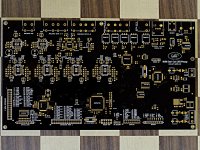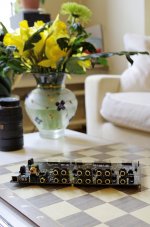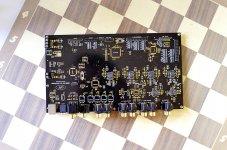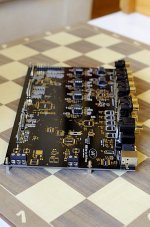I mean EQ section/biquad with same frequency as 'double biquads'. I made all biquads on unique frequency, but suddenly get two biquads with same frequency. I not open nsf file with xlm editor only used NUC.
I remember that first I understand that something is wrong as during biquad parameter tuning suddenly measured SPL line get strange, bigg hole where before was all OK. Then I closed nsf and reopened it again and find two biquads with same frequency with different G. I think error is related to DSP settings update when NUC connected to DSP and nsf file handling .
Alright Meelis, thanks for these additional details. I'll try to reproduce the bug and fix the issue.
Concerning what I said to SAC is it possible to add custom bi-quads to the crossover function. We talk about it in previous communication about that and I will find it more safe and more convenient too.
I keep it in mind, I do agree it would be convenient to be able to load custom biquads in the xovers stages as well. The difficult part here is not how to make this available in the system, but rather how to make room for this additional feature in the GUI without adding too much complexity to the interface.
I count 8 biquads for the crossover and another 4 for the PEQ, giving 12 - more than the maximum 10 Najda allows, hence the fail message.
I know your problem is solved now, but the Najda can take up to 15 biquads in each EQ stage since V.1.0.3.
Please also note that the last biquad for the woofer, upper mid and tweeter, where only the coefficient B0 is specified, is only a gain change and could be removed and set in the Nadja pre or post gain. Gan in dB = 20 Log (B0).
If you remove only the biquads where B0 = 1.0 and all other coefficients are a zero you should be set. That is, keep the biquads with B0 = 0.79 and B0 = 0.89.
I did not understand that 20log bit you mentioned so hopefully I'm done.
@Sean: what John means here is that a custom biquad coefficient set that has all zeros except B0, is in fact nothing more than a gain. The values mentioned above (0.79 and 0.89) can be expressed in terms of dB using the expression that John quoted.
So for 0.79 you get an equivalent dB gain of 20*log10(0.79) = -2.04 dB and for 0.89 you get -1.01 dB.
If you move the above gains to Najda's pre-gain or post-gain sections, then you save DSP resources. Also, everything that is in the post-gain section can be moved further to the analogue gain stage - this is very handy when you want to optimize the dynamic range of the DSP.
A little up from me.
[...]
I had not spotted that there are now 8th order X/O slopes available (not sure that they were available with the early SW releases - don't think so.
Hey Steve, great to hear from you!
8th order xovers were available right from the start though
I have one more question;
about power supply
I have swiching power supply from old NAD s170 preamplifier and it have +/-15V (and +5V)
The plan is to use it (before I build something else) and lower 15V by diode...
I have some MUR860 lying around...
http://www.fairchildsemi.com/ds/RU/RURP860.pdf
When I look at MUR860 datasheet it state that voltage drop is like 0.75V so I'm thinking to place 4 in series...
What is operating voltage of Najda ?
will it be safe to use it with 12.5V or 11.5V ?
Both 12.5V and 11.5V are safe. Nominally, Najda expects +/-12V.
Please make sure you test/check your modified power supply before you connect the Najda.
Hi Nick,
Thanks for the thorough gains explanation. I may make the alteration at some point.
I did not notice I was in v1.0.0, so have now upgraded. Visually it is certainly better at least. I do have the issue someone else mentioned here with the input of my disc spinner (coax) being much louder than my TVbox (on optical). I reduced the input signal 8.5db to eliminate clipping on the input, though still get the "bass/treble" red clipping light. Should I reduce it further? I therefore also make volume changes every time I switch input, which would be nice to automate on Najda.
Looking forward to that OLED being workable.
I would post a picture of my build if it was not so messy looking. I am holding out to see what space the expansion board might need before I go further. But it works!
Thanks for the thorough gains explanation. I may make the alteration at some point.
I did not notice I was in v1.0.0, so have now upgraded. Visually it is certainly better at least. I do have the issue someone else mentioned here with the input of my disc spinner (coax) being much louder than my TVbox (on optical). I reduced the input signal 8.5db to eliminate clipping on the input, though still get the "bass/treble" red clipping light. Should I reduce it further? I therefore also make volume changes every time I switch input, which would be nice to automate on Najda.
Looking forward to that OLED being workable.
I would post a picture of my build if it was not so messy looking. I am holding out to see what space the expansion board might need before I go further. But it works!
I´m not really interested in multichannel music, but it does seem that many multichannel releases are better mastered, with lower compression for instance, as they are designed to be played on a proper system rather than work with anything from ipods to car stereos. I did a small attempt with a Porcupine Tree album, where I ripped individual channels and mixed them into stereo. It was cumbersome, but the improvement was substantial. Steven Wilson (from Purcipine Tree) fights the loudness war, but I still think some of his albums (to CD at least) are overly compressed and tiresome to listen to.
Anyway.. to get to the point. I was wondering if a DSP chip such as the one in the Najda could be used to decode multichannel audio and downmix it with custom settings. If you have only a pair of front speakers with plenty of bass capability, the lFE channel could be mixed in with them for instance). I know there are some issues with licences etc, but I don´t think this is much of a problem in Europe (well, legal experts can correct me if I´m wrong).
If a DSP chip is overkill, perhaps a Raspberri PI with a HDMI interface could decode the sound and pass it to the Najda?
Any thoughts?
Anyway.. to get to the point. I was wondering if a DSP chip such as the one in the Najda could be used to decode multichannel audio and downmix it with custom settings. If you have only a pair of front speakers with plenty of bass capability, the lFE channel could be mixed in with them for instance). I know there are some issues with licences etc, but I don´t think this is much of a problem in Europe (well, legal experts can correct me if I´m wrong).
If a DSP chip is overkill, perhaps a Raspberri PI with a HDMI interface could decode the sound and pass it to the Najda?
Any thoughts?
I do have the issue someone else mentioned here with the input of my disc spinner (coax) being much louder than my TVbox (on optical).
Hi Sean, glad to hear your setup is running!
Regarding the level difference between your disc player and the TVbox, the only explanation I can see is that the TCbox is outputting a digital level which is not normalized to 0 dBFS. There could be a way to automate a gain in relation to the selected source. Let's think about it.
I reduced the input signal 8.5db to eliminate clipping on the input, though still get the "bass/treble" red clipping light. Should I reduce it further? I therefore also make volume changes every time I switch input, which would be nice to automate on Najda.
The amount of headroom is very much connected to the settings in the crossover and EQ section. You should set the headroom for the loudest source (disc spinner).
Regarding Bass/Treble, there's a separate headroom stage for it. You access it in the settings menu (in the same dialogue you can also customize the knee frequencies). If you add headroom here for Bass/Treble, then you can probably reduce the amount of headroom in the main section.
I´m not really interested in multichannel music, but it does seem that many multichannel releases are better mastered, with lower compression for instance, as they are designed to be played on a proper system rather than work with anything from ipods to car stereos. I did a small attempt with a Porcupine Tree album, where I ripped individual channels and mixed them into stereo. It was cumbersome, but the improvement was substantial. Steven Wilson (from Purcipine Tree) fights the loudness war, but I still think some of his albums (to CD at least) are overly compressed and tiresome to listen to.
Anyway.. to get to the point. I was wondering if a DSP chip such as the one in the Najda could be used to decode multichannel audio and downmix it with custom settings. If you have only a pair of front speakers with plenty of bass capability, the lFE channel could be mixed in with them for instance). I know there are some issues with licences etc, but I don´t think this is much of a problem in Europe (well, legal experts can correct me if I´m wrong).
Unfortunately, it seems that multichannel audio is still out of reach for diyers. There's just no simple way to retrieve the original content in PCM for now. If you can get the PCM data of multichannel content, then there's provision on the Najda for at least 8 I2S inputs and we could look at custom downmix for stereo playback.
It's been a long time I haven't seen a pic in this thread, so here's one. I've just received the new bare PCBs and they're very nice
 so I couldn't resist taking a quick snapshot. Next week I'll have the boards assembled and I'll post cleaner shots.
so I couldn't resist taking a quick snapshot. Next week I'll have the boards assembled and I'll post cleaner shots.
SEXY.
Any notable changes on the latest versions other than color? Same price? I'm considering purchasing another board for use in the studio.
SEXY.
Any notable changes on the latest versions other than color? Same price? I'm considering purchasing another board for use in the studio.
Hi Nick,
Looks good! Some words about differences? Do we need to buy the new one?
Same price yes
Differences worth to be mentioned are:
- Well, black look
- Largely improved silkscreen
- GND pads added for those who want to try short-cutting the DACs and tap the signal into the volume chip.
- Some pads revised
- All electrolytic caps are Elna audio grade now
- Assembled in EU
Those who own the previous red version don't need to worry: I commit to keep the system fully compatible.
A few more snaphots after I tested there wouldn't be any issue with connectors:



Same price yes
- All electrolytic caps are Elna audio grade now
Silmic II?
Unfortunately, it seems that multichannel audio is still out of reach for diyers. There's just no simple way to retrieve the original content in PCM for now. If you can get the PCM data of multichannel content, then there's provision on the Najda for at least 8 I2S inputs and we could look at custom downmix for stereo playback.
I am still interested in input from bluray to the Najda (mostly for movies), at least for the purpose of stereo in "high definition". We discussed this on the thread before briefly. Some possible solutions;
Current solution; let bluray player DAC output high-res to stereo RCAs, then Najda can do the ADC/DAC again. Sadly at the mercy of the players DAC.
Current solution; Pass PCM over SPDIF to Najda. Use the lossy core from DTS-HD, which is supposedly still excellent, and becoming the dominant format (75% share I think). True HD however does not offer this compromise and reverts to standard DD AC-3.
High-Def FAQ: Blu-ray and HD DVD Audio Explained | High-Def Digest
Future solution; HDMI input on Najda using the I2S,receiving PCM, but licensing will make this impossible I suspect. Does the RaspberryPi take a HDMI input from blu-ray and pass the feed to I2S? I do not think so.
So as you said Nicholas, "to get the PCM data of multichannel content" is the goal. Do we really think that is possible when this hardware/licensing is designed to prevent such info getting to the I2S on DIY hardware?
Last edited:
Very nice work!
Hi Nick,
as soon that you have the boards ready, I herewith like to place an order.
Is there somebody in the forum who tried the Exasound U2I USB to I2S board?
I have tried it and compared to WaveIO. Well, this board plays in another league! This is my personal (perhaps subjective ) opinion.
Those who want to give it a try can ask for a board at Exasound. They are making a batch of 10 for those who want the board.
Regards
Sigi
Hi Nick,
as soon that you have the boards ready, I herewith like to place an order.
Is there somebody in the forum who tried the Exasound U2I USB to I2S board?
I have tried it and compared to WaveIO. Well, this board plays in another league! This is my personal (perhaps subjective ) opinion.
Those who want to give it a try can ask for a board at Exasound. They are making a batch of 10 for those who want the board.
Regards
Sigi
If a DSP chip is overkill, perhaps a Raspberri PI with a HDMI interface could decode the sound and pass it to the Najda?
Any thoughts?
This could not work since the Pi HDMI is output only, unles that has changed in the last year.
Raspberry Pi • View topic - HDMI as an input?
What does this mean?As I still have the problem on loud explosions ans simillar.There could be a way to automate a gain in relation to the selected source. Let's think about it.
Is there somebody in the forum who tried the Exasound U2I USB to I2S board?
I have tried it and compared to WaveIO. Well, this board plays in another league! This is my personal (perhaps subjective ) opinion.
Those who want to give it a try can ask for a board at Exasound. They are making a batch of 10 for those who want the board.
I find on Exasound page information: "exaU2I is discontinued. Please contact us if you have any questions."
Is it still available, with what price?
I find on Exasound page information: "exaU2I is discontinued. Please contact us if you have any questions."
Is it still available, with what price?
Yes, they are producing again a batch of 10 boards. There exists a non official homepage where you can order(www.exadevices.com > eStore > exaU2I. It is not cheap, it costs I think 320 canadian $.
Regards
Sigi
Current solution; Pass PCM over SPDIF to Najda. Use the lossy core from DTS-HD, which is supposedly still excellent, and becoming the dominant format (75% share I think). True HD however does not offer this compromise and reverts to standard DD AC-3.
High-Def FAQ: Blu-ray and HD DVD Audio Explained | High-Def Digest
I was still unsure about whether the bluray stereo downmix was hi-res but this manufacturer reply seems to confirm only analogue outputs will pass this.
"This is what OPPO said in reply to my email requesting information about the dedicated 2-channel analogue output on the BDP-83:
The player will be performing the DownMix from the high resolution audio track, such as DTS-HD Master or Dolby Digital TrueHD, when this track is available.
You will not be able to use the digital coaxial or optical outputs on the BDP-83 to transmit DTS-HD Master or Dolby Digital TrueHD. These outputs are always the lossy core containers.
For best performance, you will use the dedicated analog Stereo output."
Good for me the Najda has stereo inputs! Time for a new blu-ray player.
"This is what OPPO said in reply to my email requesting information about the dedicated 2-channel analogue output on the BDP-83:
[...]
For best performance, you will use the dedicated analog Stereo output."
Good for me the Najda has stereo inputs! Time for a new blu-ray player.
If you're not afraid of hacking your BDP-83 (which must be way out of warranty by now), try sleazing the I2S feed to the stereo output DAC into one of these:
Teleporter Digital Transfer Module
...and transmit the I2S to the Najda. That should solve your decoder problems.
DSP_Geek
Very interesting product, especially being four channels which theoretically would do me for surround sound through the Najda, but beyond my skills really. I will probably settle for the easiest path, getting a decent blu-ray like this one which does RCA stereo out using ADC BurrBrown 192@32bit;
DENON UK | DBT-1713UD
Sorry, the quote was from someone else. I do not have an Oppo83, but an old Sony350.
Very interesting product, especially being four channels which theoretically would do me for surround sound through the Najda, but beyond my skills really. I will probably settle for the easiest path, getting a decent blu-ray like this one which does RCA stereo out using ADC BurrBrown 192@32bit;
DENON UK | DBT-1713UD
Sorry, the quote was from someone else. I do not have an Oppo83, but an old Sony350.
The amount of headroom is very much connected to the settings in the crossover and EQ section. You should set the headroom for the loudest source (disc spinner).
Regarding Bass/Treble, there's a separate headroom stage for it. You access it in the settings menu (in the same dialogue you can also customize the knee frequencies). If you add headroom here for Bass/Treble, then you can probably reduce the amount of headroom in the main section.
Nothing I do removes the input clipping warnings (ADC and bass treble). Now that I got the Denon blu-ray unit today, I am using the stereo input on Najda, not coaxial. I have again the the level jump. The analogue input overloads badly, the sound distorting unpleasantly.
SETTINGS tried alone and in combination, without success;
bass/treble settings - headroom: 6db added
input gain setting: -24db (though this stops the worst audible distortion on analogue input)
channel processing, pre and post gain: -10db on each (all channels)
INPUTS
optical - seems ok
analogue - ADC/clipping almost constantly
- BASS-TREBLE/clipping almost constantly
What else can I do? Constant clipping like this is surely not acceptable?
P.S. I am using 2Vrms output level. My 41Hz amp9s are, according to the manual "Line level analogue audio inputs with fixed 30dB gain & input impedance 50K". Not sure how to interpret this.
Last edited:
Having researched a little myself, it sounds like analogue in to a DSP is asking for input/output problems. This discussion sounded like my situation;
"One issue with DSP units is input/output gain structure. You have to drive the input to a certain level to get the signal encoded properly by the ADC. Too low and the signal gets encoded at less than 16 bits of resolution, too high and the input overloads.....analog in is not the best way to use a digital DSP unit"
I may have to return this bluray player since it has only HDMI/RCAs, unless anyone thinks I am missing something on the Najda settings?
"One issue with DSP units is input/output gain structure. You have to drive the input to a certain level to get the signal encoded properly by the ADC. Too low and the signal gets encoded at less than 16 bits of resolution, too high and the input overloads.....analog in is not the best way to use a digital DSP unit"
I may have to return this bluray player since it has only HDMI/RCAs, unless anyone thinks I am missing something on the Najda settings?
- Home
- Source & Line
- Digital Line Level
- DSP Xover project (part 2)